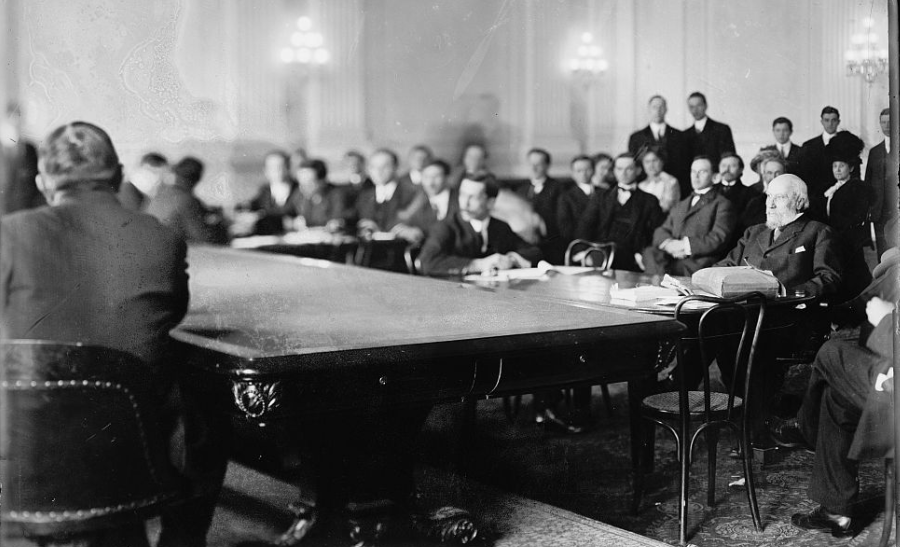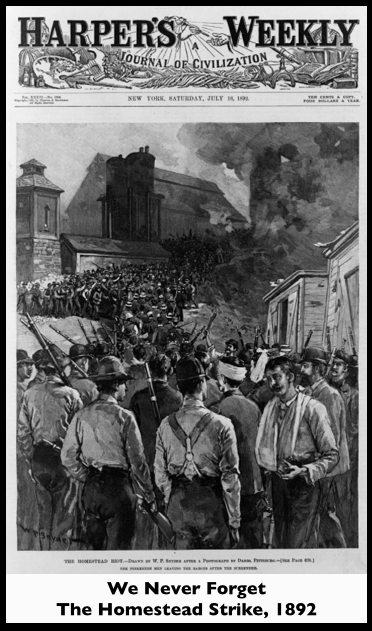
~~~~~~~~~~~~~~~~~~~~~~~~~~~~~~~~~~~~~~~~~~~~
Hellraisers Journal, Thursday March 7, 1918
Steel Town, U. S. A. – Some Improvements Yet Long Hours Continue
From the Appeal to Reason of March 2, 1918:
Labor Conditions in Steel Trust.
There has been some improvement in the conditions of labor in the steel mills, as the figures show, but it is an exceedingly slight improvement. The Steel Trust investigation of 1911-12, made by the Stanley committee of the House of Representatives, revealed an almost unbelievable state of exploitation, of long hours, of low wages and generally servile conditions. Those revelations were subsequently confirmed by the report of the Federal Labor Bureau, then under the direction of Charles P. Neill. Thereupon a committee of the more humane stockholders of the trust (the Cabot committee) insisted upon certain changes in conditions, and some of these changes have since been slowly under way. By 1913 there had been a slight reduction in hours. There has also been some increase in wages, but the increases have not kept pace with the rise in food prices.
Bulletin 218 of the Bureau of Labor Statistics, published last October, gave a detailed study of wages and hours in this industry to June, 1915. It is shown that in the blast furnaces 59 per cent, of the employes in 1915 worked seven days a week, as against 80 per cent, in 1911. In 1909 no one in the blast furnaces on full time was working less than 60 hours per week, while 26 per cent, were working form 60 to 83 hours, and 74 per cent, were working a full 84 hours. In 1915 6 per cent, were working under 60 hours, 53 per cent. from 60 to 83 hours and 41 per cent, a full 84 hours. Even with the reduction made, these still remain inhumanly long hours.
Full-time weekly earnings in the blast furnaces, represented by the index number 94 for 1910, rose to 104 in 1913, but fell to 100 in 1914 and 1915. The net increase in wages between 1910 and 1915 was thus 6 per cent., an actual loss in purchasing power. Successive increases in wages have been announced since then. But as they apply to various departments in many plants and as few of these reports give the number of workers affected, no generalization can be accurately made. It seems likely, however, that since the beginning of 1916 there have been substantial increases in wages, affecting probably all the workers in this industry, and that these increases have at least equalled, if not exceeded, the rise in prices.
* * *
Steel Trust’s Profits.
The United States Steel Corporation paid the government $212,467,249 in war income and excess profits taxes in 1917 and still had a total of net earnings about equal to that of 1916. The figures are $331,668,131, against $342,997,092 the previous year, before the war taxes were levied. Holders of common shares during 1917 drew 17 per cent. on their investment. There was a total disbursement of 18 per cent., one per cent. having been voted for the Red Cross.
———-
[Photograph added.]
SOURCE
Appeal to Reason
(Girard, Kansas)
-Mar 2, 1918
https://www.newspapers.com/image/67313128/
IMAGE
Homestead Strike, Harpers Weekly, July 16, 1892
https://en.wikipedia.org/wiki/Homestead_strike
From Harper’s Weekly Volume 36
https://play.google.com/books/reader?id=Kxo7HS9wWf4C&printsec=frontcover&output=reader&hl=en&pg=GBS.PA673
See also:

Steel Workers, James Hill bf Stanley Com, LOC, Jan [Feb] 12, 1912
https://www.loc.gov/resource/hec.00558/
United States Steel Corporation: Hearings Before the Committee on Investigation of United States Steel Corporation. House of Representatives. Volume 4 [of 8 Volumes], Issues 36-49
-Augustus O. Stanley, Chairman
Govt. Print. Off., 1912
https://books.google.com/books?id=oFA-AAAAYAAJ
No. 48: Feb 12, 1912
https://play.google.com/books/reader?id=oFA-AAAAYAAJ&printsec=frontcover&output=reader&hl=en&pg=GBS.PA3109
Afternoon Session: Testimony of James J. Hill
https://play.google.com/books/reader?id=oFA-AAAAYAAJ&printsec=frontcover&output=reader&hl=en&pg=GBS.PA3151
The report by Commissioner of Labor Charles P Neill was made in 1913:
“Conditions of Employment in the Iron and Steel Industry, Investigation Made by the Board of Labor.”
The name of this report is from CIR page 7455 (sadly, have not yet found Neill’s report online)
https://play.google.com/books/reader?id=DIFRAAAAYAAJ&printsec=frontcover&output=reader&hl=en&pg=GBS.PA7455
“Cabot Committee” search yields few results, but I did find this from
The Iron Trade Review of April 23, 1914:
“A Water Tender Leads in Prayer, When workingmen attend annual meeting of United States Steel Corporation”
https://play.google.com/books/reader?id=n3I-AQAAMAAJ&printsec=frontcover&output=reader&hl=en&pg=GBS.PA738
Monthly Review of the U. S. Bureau of Labor Statistics
-U. S. Department of Labor Bureau of Labor Statistics
WDC, 1918
https://books.google.com/books?id=nQgQoTP73vsC
Re: Bulletin 218
https://play.google.com/books/reader?id=nQgQoTP73vsC&printsec=frontcover&output=reader&hl=en&pg=GBS.RA1-PA136
“Wages and Hours of Labor in the Iron and Steel Industry, September, 1917, Compared with May, 1915.”
-by N. C. Adams
https://play.google.com/books/reader?id=nQgQoTP73vsC&printsec=frontcover&output=reader&hl=en&pg=GBS.RA2-PA29
To view Bulletin 218:
Wages and Hours of Labor in the Iron and Steel Industry, 1907 to 1915 : Bulletin of the United States Bureau of Labor Statistics, No. 218
WDC, Oct 1917
https://fraser.stlouisfed.org/scribd/?item_id=476888&filepath=/files/docs/publications/bls/bls_0218_1917.pdf
Men and Steel
-by Mary Heaton Vorse
NY, 1920
https://catalog.hathitrust.org/Record/001432246

